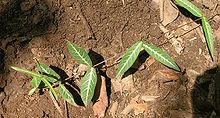Hemidesmus indicus, Indian sarsaparilla, is a species of plant found in South Asia. It occurs over the greater part of India, from the upper Gangetic plain eastwards to Assam and in some places in central, western and South India.
| Indian sarsaparilla | |
|---|---|

| |
| Scientific classification | |
| Kingdom: | Plantae |
| Clade: | Tracheophytes |
| Clade: | Angiosperms |
| Clade: | Eudicots |
| Clade: | Asterids |
| Order: | Gentianales |
| Family: | Apocynaceae |
| Genus: | Hemidesmus |
| Species: | H. indicus
|
| Binomial name | |
| Hemidesmus indicus | |
| Synonyms | |
| |
The root is a substitute for sarsaparilla (the dried root of the tropical species of Smilax, Smilacaceae; in India Smilax aspera L., and Smilax ovalifolia Roxb.). It should be distinguished from Mexican Sarsaparilla Smilax aristolochiifolia Mill. and Jamaican Sarsaparilla Smilax ornata Hook.f..[1][full citation needed]
Names
editIn India, it is called ananthamoola, also known locally in Southern India as naruneendi or nannari.[2]
Description
editIt is a slender, twining, sometimes prostrate or semi-erect climber.[3] Roots are woody and aromatic. The stem is numerous, slender, terete, thickened at the nodes. The leaves are opposite, short-petioled, very variable, elliptic-oblong to linear-lanceolate. The flowers are greenish outside, purplish inside, crowded in sub-sessile axillary cymes.[citation needed]
Traditional uses
editHemidesmus indicus is used to make beverages like nannari sharbat, and is used in traditional medicine.[4]
In southern states of India (particularly Tamil Nadu), the pickled roots are served along with rice dishes.
Chemical constituents
editThe roots of H. indicus contain hexatriacontane, lupeol, its octacosanoate, α-amyrin, β-amyrin, its acetate and sitosterol. It also contains new coumarino-lignoid-hemidesminine, hemidesmin I and hemidesmin II50, six pentacyclic triterpenes including two oleanenes, and three ursenes. The stem contains calogenin acetylcalogenin-3-0-β-D-digitoxopyrannosyl-0-β-D-digitoxopyronsyl-0-β-D-digitoxopyranoside. It also afforded 3-keto-lup-12-en-21 28-olide along with lupanone, lupeol-3-β-acetate, hexadecanoic acid, 4-methoxy-3-methoxybenzalaldehyde and 3-methoxy-4-5methoxybenzalaldehydglycosides-indicine and hemidine. The leaves contain tannins, flavonoids, hyperoside, rutin and coumarino. Leucoderma lignoids such as hemidesminine, hemidesmin I and hemidesmin II are rare group of naturally occurring compounds present in leaves.[5][6]
References
edit- ^ Puri 2003
- ^ "Ayurvedic Medicinal Plants Naruneendi Nannari". Archived from the original on 2014-08-08. Retrieved 2014-04-23.
- ^ Bonne, Kerry; Mills, Simon. Herbal approaches to pathological states In Principles and Practice of Phytotherapy. Churchill Livingstone: Elsevier.
- ^ Indian medicinal plants: a compendium of 500 species. Vol. 3 (1 ed.). Madras: Orient Longman. 1996. ISBN 9788125003021. Retrieved 26 May 2013.
- ^ "Sariva (Hemidesmus indicus)". National R&D Facility for Rasayana. Government of India. Retrieved 14 March 2016.[permanent dead link]
- ^ "Anantmool". Konark Herbal and Healthcare. Retrieved 14 March 2016.